Contribution of Internet of Things to Marketing
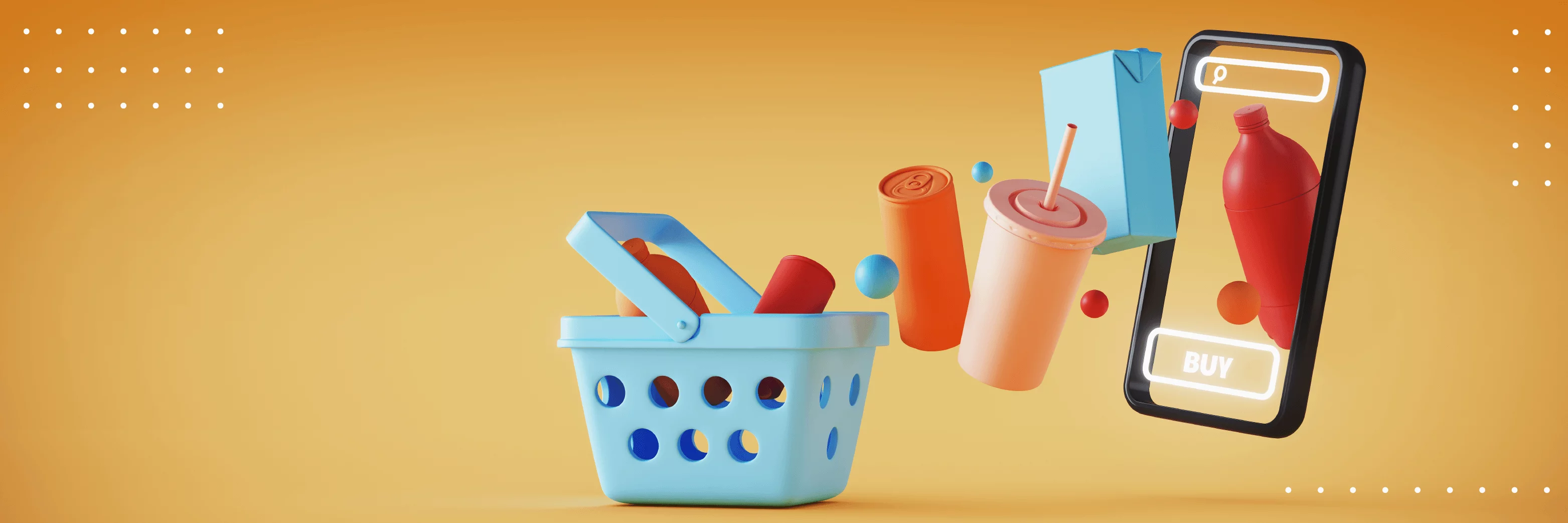
Key takeaways
-
IoT in marketing has two main functions: fast data tracking and data transformation into vital information.
-
The data analyzed via IoT tools throws a light on the existing marketing strategy in the company so that it can be improved in the future.
-
Modern business requires new customer approaches, such as the personalization of seller-customer interactions. Read how IoT helps make it fast and efficient.
IoT in marketing: brief overview
Do you know how much money companies spend on their marketing campaigns? And how much of these sums prove to be ineffective? Underneath, you can see some convincing statistics:
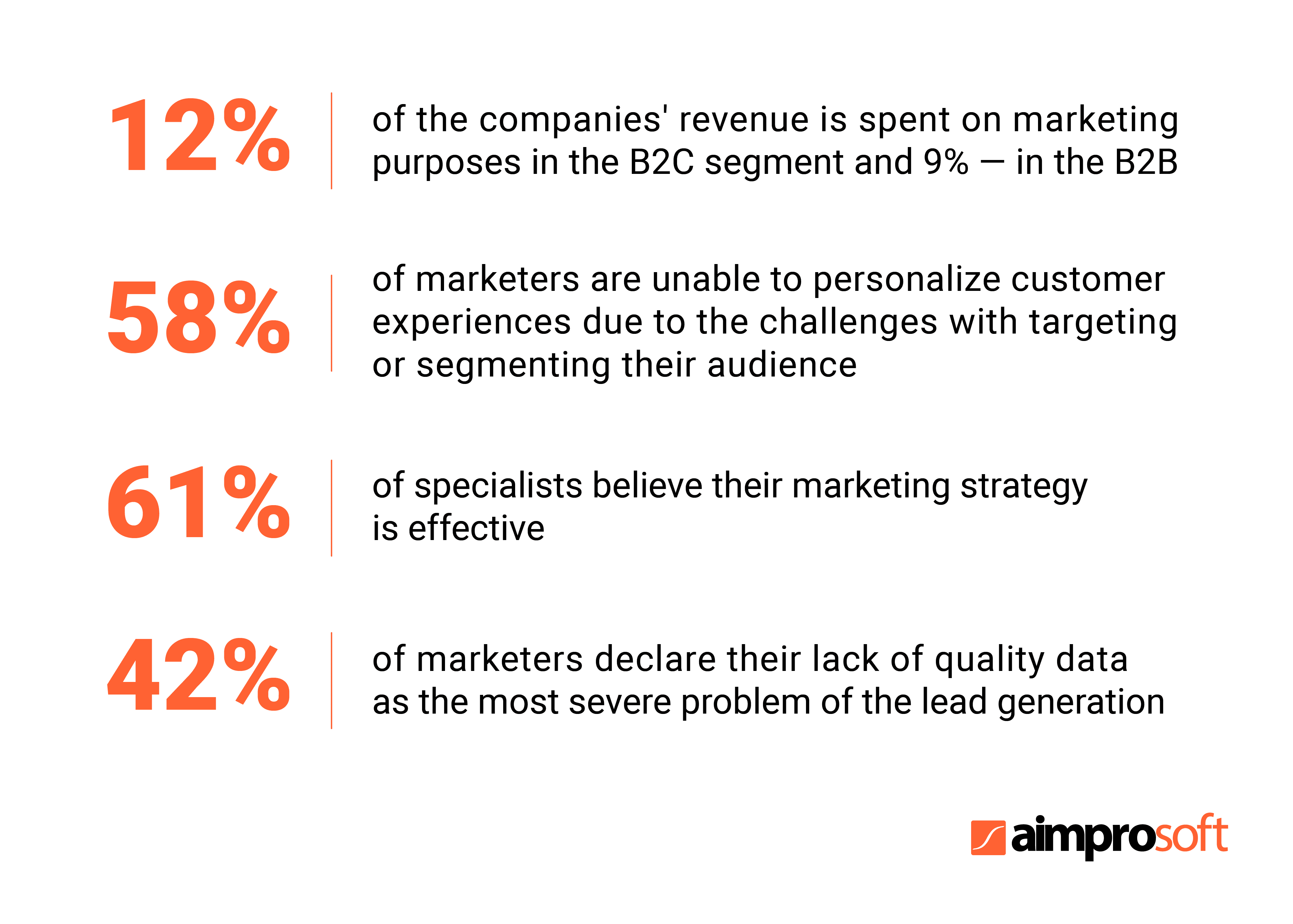
Nobody can tell the seller about the needs of a buyer better than the buyer himself. And here, the IoT appears to be the answer to essential problems stated above. IoT provides you with the ability to not only create and collect some data but, importantly, make huge use of it: from making the brand/product more recognizable to creating a new experience of interaction with a brand for customers via innovative IoT Marketing Strategy.
Those who bind IoT and Marketing earlier will have the most outstanding advertising campaigns, thus, will boost customers’ engagement. But what are the functions of the Internet of Things in marketing? Scroll down to see.
Top Internet of Things marketing functions and the ways they are used in marketing
Probably you have heard the phrase “Who possesses the information, possesses the world” by Nathan Mayer Rothschild. This quote is the very core of IoT Marketing nature because it allows you to have closer seller-customer bounds by using digital connections. IoT hardware consists of sensors that make possible the existence of the first function — data tracking performed through different connected devices.
Data tracking became much easier, real-time, and of better quality, which allows marketers to understand exact “right-here” customer behavior and needs. This understanding enables such specialists to change their marketing campaigns very fast and provide more personalized product promotion.
For example, smarthome things — door locks, bulbs, kitchen devices, etc. can gather information about the everyday life habits of a customer. Wellness devices are also well-known IoT data resources: they can gather the data about your behavior connected with health and track your whereabouts to understand the level of activity. The product shops keep in step and leverage IoT to analyze the data about the product’s way from the shelf to the customer.

The key to a successful marketing strategy is how fast collected data is analyzed and applied. Data transformation into vital information is the second important realized function of the Internet of Things in marketing with the help of AI (Artificial Intelligence) and ML (Machine Learning). Both technologies are integrated into a cloud platform or fogs, which are IoT components.
Now let’s have a deeper look at how the Internet of Things and marketing works through the concept of 4Ps: product, price, place, and promotion.
-
Product
With the help of RFID (Radio-Frequency Identification) and WSNs (Wireless Sensors Networks technologies), the company can track in real time how customers react to the color/shape of the product, how they use it, which features they prefer, etc. Going through all these stages, the customer himself becomes partly a creator of products’ features.
-
Price
Frequency of the purchase made, how recently a customer buys a product, and how much he/she spends — all that has a significant impact on the price formation. With massive data collected and promptly analyzed via IoT, you can upgrade this process to a much higher level.
-
Place
Concerning place, we can implicate two fields: online and physical Points of Sale. The above-mentioned RFID and WSNs let a marketer define a better place for product distribution through understanding customer segmentation. IoT can significantly shorten the time for such data collection and analysis and, thus, help companies increase their revenue.
-
Promotion
Within the scope of Marketing and Internet of Things, personalization is still a growing and highly promising trend. With a lot of data gathered via an IoT solution, a company can target its customer in the best possible way, monitor the changes in his/her preferences, purchase patterns, and make the content that perfectly matches a certain customer’s needs. Such promotional methods form a considerable part of a perfect Internet of Things marketing strategy.
Our specialists will answer all your questions.
Talk to usThe most popular IoT marketing examples
There are a lot of spheres in marketing where the IoT can be applied. Let’s browse through the 3 brightest Internet of Things marketing examples.
“MirrorMe” IoT app from Mary Kay
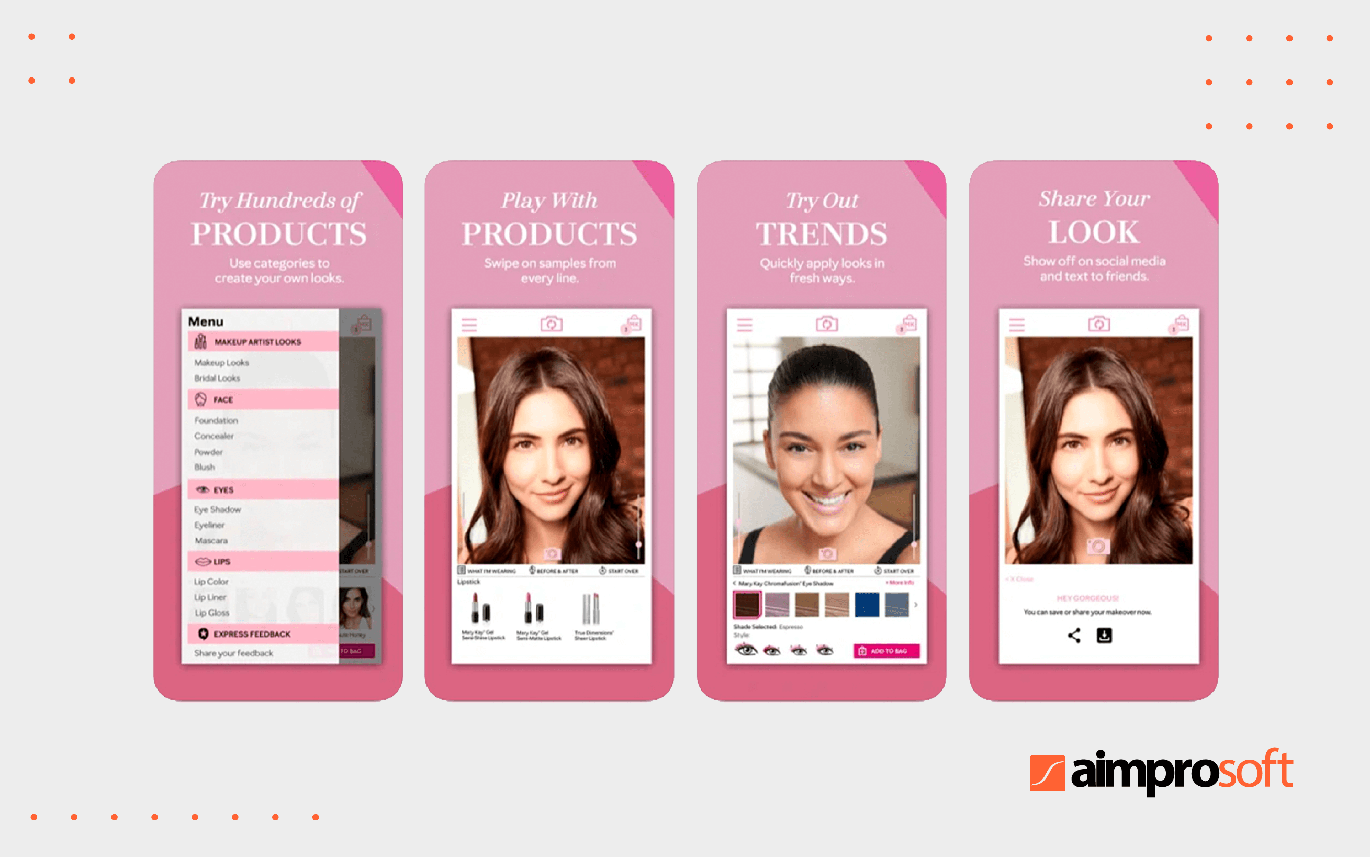
Industry: beauty
The purpose of an IoT appliance: personalization of customers’ buying experience based on their preferences.
Description: this app allows a customer to “try” through the camera a certain make-up developed by make-up artists and thus assess the whole look with some products combined together, or try them separately. After choosing a number of products that he/she likes, a customer can add them to the shopping cart and make the purchase with the help of Mary Kay’s Independent Beauty Consultant.
By combining marketing and an IoT app, the business can gather information for precise analysis of customers’ preferences and, on the basis of these insights, build the new marketing strategy or make necessary changes to the existing one.
Outcome: the plan for such an app realization first was initiated by Mary Kay as far back as 2013 (it was named “Virtual Makeover App”). At that time, the company started to put much more value upon IoT in marketing. This intention was fully completed with the MirrorMe App, which nowadays has 5 of 5 ratings in the Apple App Store and more than 100,000 downloads at Google Play.
“Smart bottles” from Johnnie Walker Blue Label (Diageo)
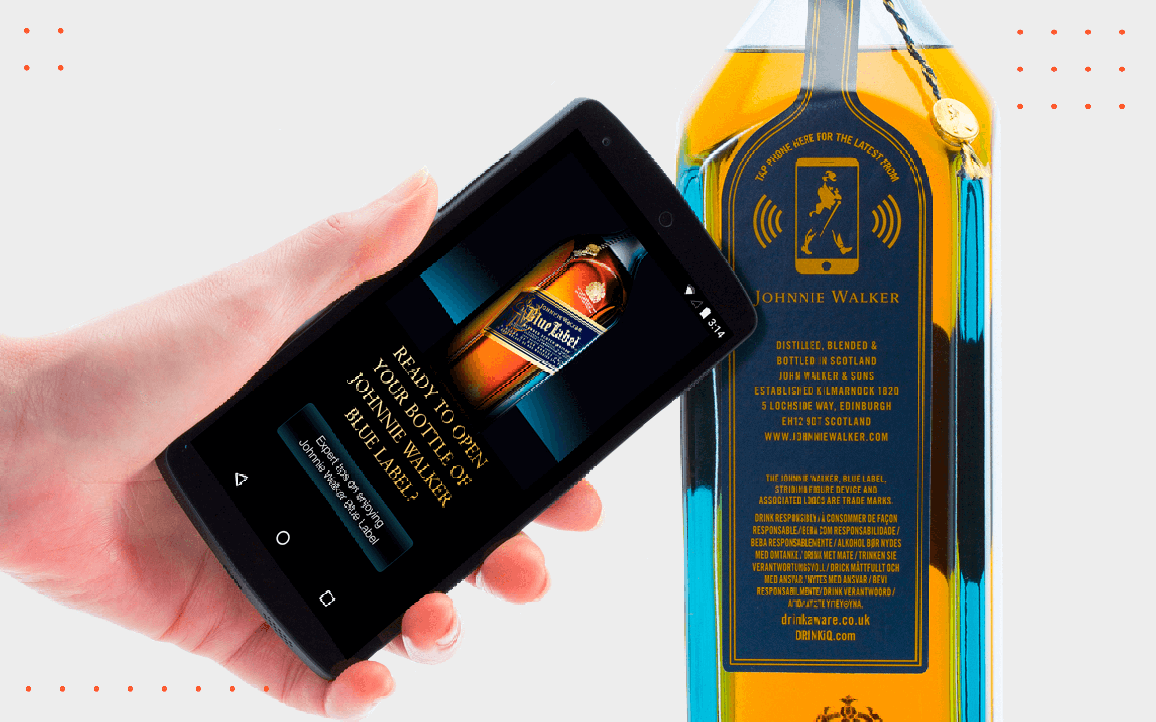
Industry: alcoholic beverages
The purpose of an IoT appliance: make direct interaction with a customer and let him/her have a more profound customer experience during different promotion campaigns.
Description: Diageo launched a great marketing campaign with the help of Near Field Communication (NFC) capabilities, which enable smartphones to communicate with each other when they are in close proximity. This technology let not only track a bottle on its way from the shelf to the buyer but also determine a separate customer and make the promotional offer more personalized. Such technology can even help Diageo create an extra security layer by protecting the product’s originality and thus earn the customers’ additional trust.
Outcome: the company additionally used social media to conduct the promotion which appeared to be a bright IoT marketing experience for customers. It allowed Diageo to show up among the other brands and had a 72% sales growth with 100,000 marked bottles sold. On Father’s Day in Brazil, Diageo let customers personalize their bottles digitally with the help of a QR code. When a father received the customized bottle, he could scan the code and see the video congratulation recorded by his son or daughter.
Amazon Echo smart speaker
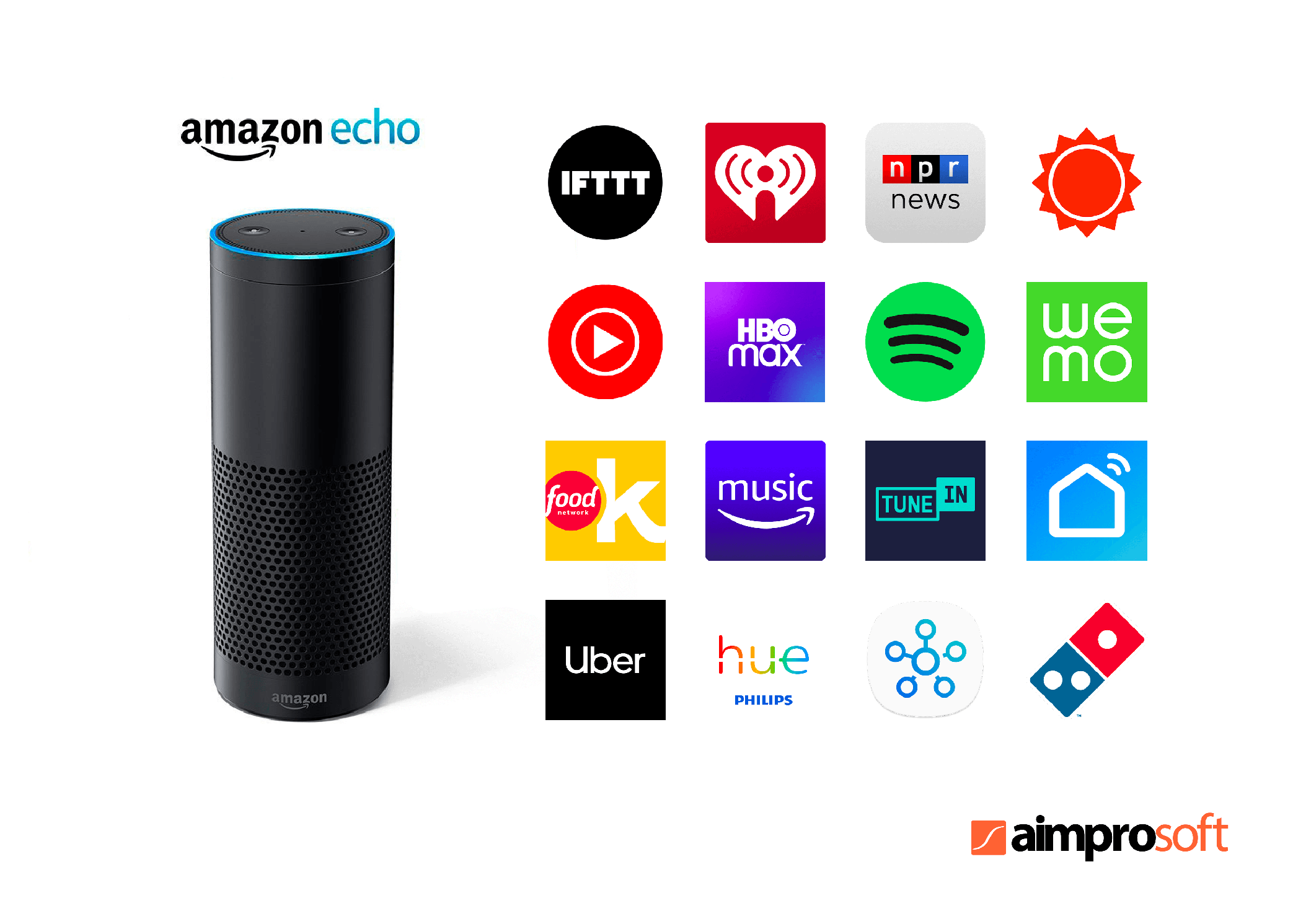
Industry: consumer devices
The purpose of an IoT appliance: create a smart home system to manage everyday tasks only with your voice and call certain services by Echo smart speaker.
Description: the whole idea of a smart speaker is basically built on the concept of IoT. To interact with Echo, you need to call it. The device has intelligent technology called Alexa Voice Service (AVS), which is learning to accurately focus on your voice, recognize commands and execute them.
To use the Echo’s application, you need to log in to your Amazon account. This means that you give vital information to the speaker (your location, buyers’ history, etc.) to fulfill your needs. Based on this information, Echo can offer you the best service options according to your requests, such as ordering pizza, booking a restaurant, or calling Uber.
Amazon Echo has its own “Play Market” called Alexa Skills. It has a lot of benefits not only for customers who can personalize their smart speakers but also for the companies and single individuals who can add their app to the Skills with the help of the Alexa Skills Kit and thus have additional customer traffic and new data for better sales analysis.
Outcome: it was estimated that in 2020 from the overall amount of 83.1 million smart speaker users in the USA, 69.7% used an Echo, which means a vast business area for companies’ new digital marketing campaigns with quick monitoring of customers’ response.
If you want to make an app but don’t know yet how to start, our dedicated team will help you implement your idea and reach success.
Pros and cons of use IoT in marketing
Like any other technology, IoT has its own advantages and disadvantages. In the following table, we will look into the most significant ones.
| Pros | Cons |
|---|---|
| It lets a seller have a deeper understanding of customer behavior and thus have a much more effective personalized IoT marketing strategy. | One of the greatest challenges for the company is data privacy and security. It’s clear now that, although there are certain standards of data collection and storage, it can’t cover all the issues concerning IoT technologies which are developing very fast. The company’s task is to ensure the customer that his/her data given to the company will be collected and protected in the best possible way. |
| IoT helps companies decrease costs and procedures connected with the data collection and analysis and lets the marketers manage human-skill-required tasks. | It is important to understand that creation of such an IoT system requires highly skilled professionals with the corresponding experience. Therefore, it can be quite a challenge for the company to find such specialists. The solution may lay in applying the services of an offshore or nearshore software development company with lower rates still great IoT expertise. |
| It’s a way to give a customer a new experience with the help of IoT devices and software and develop new customer-seller relationships. | The implementation of IoT in business demands investment and all the necessary equipment. That’s why the aims of IoT use must be clear and justified. |
IoT, despite its challenges, has a bright future in terms of marketing. If you want to have customers deeply interested in your products and services and also have more efficient data analysis with its appliance, IoT can be of big help for it.
How to develop an IoT app that would benefit marketing
When creating an IoT marketing app, you’ll have to develop the 4 inherent IoT stages. Let’s start from the beginning:
1. Choose the hardware
It is the initial stage of the IoT app development. Hardware involves various devices such as sensors, chips, measuring appliances, mobile phones, etc. It can be self-produced or bought from a third-party manufacturer. In any case, you should define the hardware characteristics to comply with the required performance.
2. Select the network
The network connects the whole IoT system and transfers the data from sensors and smart devices to mobile/web applications in both directions. When selecting the network connectivity methods (LPWAN, LAN, cellular, satellite, WiFi, Bluetooth, etc.), consider bandwidth, a distance of connection, and power consumption suitable for your IoT project.
3. Decide on the IoT cloud platform
A ready-made cloud platform simplifies and speeds up IoT solution development covering the whole range of services: from device control, data collection, storage, and processing to providing data analytics. For most IoT projects, leveraging an IoT cloud platform is the optimal solution but if you have specific business requirements, you may opt for on promises data storage, thus will have to develop everything from scratch.
You can get additional information about how to build an IoT app in our blog article
4. Develop an application
For the backend building of an end-user app, we suggest the microservices architecture. This approach is based on the creation of small independent services with their own sets of code that perform particular functions. For more effective use, they can be decomposed into containers. Such containerization is beneficial for the IoT solution as it allows easy updating and scaling of these services without changing other parts, which finally ensures faster app’s time to market and reduced development costs.
To make your IoT app of great virtue not only for the end users but also for your marketing specialists, we also suggest developing an admin panel where he/she will be able to see reports, graphs, diagrams, and the required statistics with relevant data.
For marketing managers’ convenience, it is better to display such reports via a web app. And to make the reports available wherever they are, marketing data should be shown via mobile clients. In this case, we suggest a hybrid app development because:
- it ensures you deploy your IoT app on 3 platforms simultaneously, which is time and money saving;
- to interact with hardware, platform-specific features for Android and iOS platforms should be based on the native shell provided by hybrid development.
You’ll be able to disclose the marketing data only to an authorized group of people by assigning roles and permissions to your IoT app users.
As you can see, hybrid development is usually the most feasible to make your IoT app useful for gathering and analyzing marketing data. However, everything depends on your particular case. Therefore, native or cross-platform development can be also an option for the integration of Internet of Things and marketing. To know exactly, you should consult your software vendor that will prepare a business proposal with the required data.
In the table below, you’ll find the most frequently used technologies for hybrid, cross-platform, and native IoT app development:
| Hybrid |
Programming Languages: CSS, HTML, JavaScript UI Frameworks: Quasar, React Native, NativeScript, Ionic, Xamarin, Axway Appcelerator, Adobe PhoneGap, React Native Cross-platform GUI toolkits: Qt, jQuery UI, MooTools, Webix |
| Cross-platform |
Programming Languages: JavaScript, Python, C#, C++ UI Frameworks: React Native, Ionic, Xamarin, Flutter, Appcelerator, Adobe PhoneGap, Cordova, NativeScript Cross-platform GUI toolkits: Qt, JUCE, Kivy, Qt Project, Dear ImGui |
| Native iOS platform |
Programming Languages: Swift Toolkits: Xcode, AppCode SDK: iOS SDK UI Frameworks: UIKit, SwiftUI |
| Native Android platform |
Programming Languages: Java, Kotlin Toolkits: Android Studio SDK: Android SDK UI Frameworks: Android UI, Jetpack Compose |
| Analytics tools | Google Analytics, Mixpanel, Grafana, Microsoft Power BI, etc. |
Based on the information given above, there are plenty of options for platforms and tools for IoT apps development in terms of marketing use. Our specialists have gained broad experience in such software writing. In the next section, we will show one of our company’s cases as an example of Internet of Things and marketing combination.
Create an IoT app for marketing with Aimprosoft
A company, the telecom provider, came to us with the request to develop an IoT app for real-time delivery of information about their services to the customers. The client built an Innovation Center where a customer, being close to the exhibition item, saw the push notification about IoT connected objects in the app with articles describing the latest groundworks in ICT (information and communications technology). By doing this, the client wanted to create a unique experience for customers and draw their attention to the company services.
An app had to work on both iOS and Android platforms. Our developers built the apps’ backend based on the Liferay platform that provided OOTB (Out of the Box) functionality for fast and easy content delivery via categorization.
The main challenge was to enable clients’ Android apps to determine their proximity to iBeacon hardware. When a visitor was located in the area of the active beacon, the app found the associated content in the database and showed it to the customer.
As a result, the provider had two apps for iOS and Android capable of tracking clients’ location via Bluetooth low energy (BLE) beacons and could make the efficient updating through API. The developed solution drew customer’s attention on the spot by imparting informational articles directly from the app via push notifications.
If you are considering location-based mobile app creation, read the opinion of our top specialists on how to approach it from a technical point of view.
Such an app has become a great asset for both the client and his customers. A customer has got all the newest information, promotion offers and even could ask questions about the groundworks in ICT. At the same time, our client has acquired opportunities for self-promotion and has got more related customer data to define their current interests and thus modify marketing campaigns to get more profit in the future.
Conclusion
Making the use of bundled marketing and IoT is a worthy step for a wide variety of businesses. If you don’t know where to start from and how to implement such technologies properly, please contact us — our professional team is ready to help you with all sorts of IoT app development requests.
FAQ
How can I create a better customer experience for my clients with the help of IoT?
You’ll get a deep understanding of customer behavior via analytics, so you can make your customer feel very valuable by personalizing your company’s marketing campaigns. Moreover, you’ll be able to react faster to customer needs that also will result in the growth of his/her trust in your company. The more your products or services are “responsive”, the more your clients are satisfied.
How should IoT data be provided for the marketing department?
For more convenient use, we suggest developing an app where marketing managers will have different means for data analysis. It’s done by assigning your marketers proper roles and developing an admin panel for them. All collected data will be analyzed and shown as reports, graphs, diagrams, and the other required statistics. For more information, see the section “How to develop an IoT app that would benefit marketing.”
What will be the impact on my sales if I leverage IoT for marketing?
IoT will let you get precise marketing data faster and with less effort; therefore, respond very quickly to your customers’ needs and foresee future trends. A good IoT marketing example is the campaign from Johnnie Walker Blue Label. The company saw the need for creating a new customer experience and made it with the help of IoT, which resulted in a 72% sales uplift. For more information, read the section “Top Internet of Things marketing functions and the ways they are used in marketing.”




